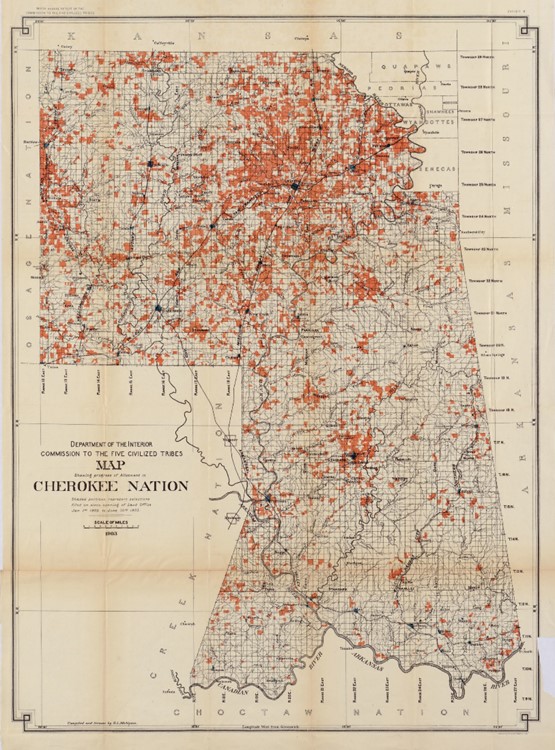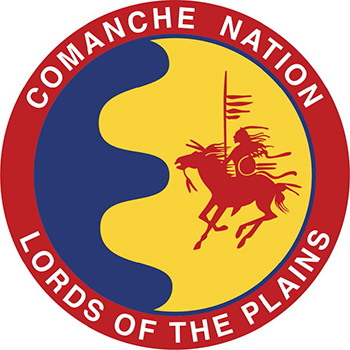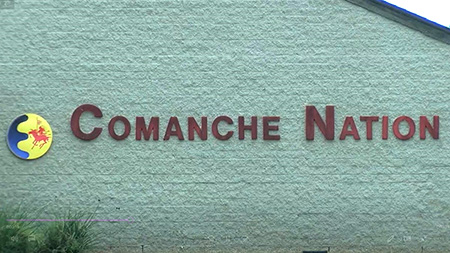
Government
Tribal Governments
The stories of tribal nations and the state of Oklahoma are intertwined. The tribal nations and their governments predate the state of Oklahoma. In 1877, the US government adopted the policy of breaking up the land held by the tribes and reassigning small pieces to individuals with the Dawes Allotment Act. Although there were factions of tribal members who thought this was a good idea, tribal governments forcefully resisted. In response, the US government passed the Curtis Act in 1898, which weakened the tribal governments. This period led to the movement of around 90 million acres to the ownership to non-Indians, or two-thirds of tribally-held land.
In the 1920s, observers noticed these policies had been destructive. In 1928, the Merriam Report, examining the results of an investigation into conditions for tribal members after allotment, was released. The report documented the challenging conditions that existed in Indian country. It argued that allotment had failed in its stated goal to improve the lives of tribal members and stated the government needed to act to address the problems it caused. This report led to the creation of a package of laws during the presidency of Franklin Delano Roosevelt that people called the “Indian New Deal.” The most important law in this New Deal was the 1934 Indian Reorganization Act. This law included guidelines to reestablish strong tribal governments. However, this law did not apply to the Native nations in Oklahoma. In 1936, Senator Elmer Thomas sponsored the Oklahoma Indian Welfare Act to extend the Indian Reorganization Act to nations in the state. Not all tribes accepted the offer to rebuild governments under the guidance of the Bureau of Indian Affairs but many did.
Later, in the 1970s and 80s, there was another period of establishing and strengthening tribal governments. It is important to understand how tribal governments work since these governments exist within the state and often serve the same people. The tribal nations within Oklahoma are sovereign nations. That means they have the authority to make decisions about their own nation, land, and people. At times, the tribal government may offer services to both tribal members and non-members within their jurisdiction. Here are examples of how tribal governments are organized.

An allotment map of Cherokee Nation, 1930 (image courtesy Library of Congress).

Wilma Mankiller became the Cherokee Nation’s first elected woman chief in 1987 (2012.201.B0381.0404, OPUBCO Photography Collection, OHS).
Cherokee Nation
The Cherokee Nation is one of the Five Tribes, a group of tribes originating in the southeastern part of what would become the United States and forcibly removed to Indian Territory in the 1830s and 1840s. These tribes adopted many elements of the colonizing American culture, including the structure of government, both in their original homeland and in Indian Territory. The Cherokee Nation’s government today is similar to that of the US federal government.
Executive
The Cherokee Nation’s executive branch functions much like the United States executive branch. It establishes tribal policy that implements the laws passed by the Tribal Council. The executive branch also runs day-to-day tribal operations. The principal chief and deputy principal chief lead it. The Tribal Council confirms a cabinet picked by the principal chief. The principal chief and deputy principal chief are elected every four years by a popular vote of Cherokee Nation citizens.
Legislative
Called the Tribal Council, the Cherokee Legislature is a representative group of seventeen Cherokee Nation citizens. They are picked every four years by popular vote. Fifteen of the seventeen represent districts inside the Cherokee Nation. The other two represent districts outside the nation. Their goal is to establish laws for the Cherokee Nation and further the interests of the Cherokee people. An example of this was when the Tribal Council signed a $2,000 relief bill for each Cherokee citizen using federal money.
Judicial
This branch serves to hear and solve disputes concerning laws and the Cherokee Constitution. The judiciary is made up of the District Court and the Supreme Court.
District Court
The district court serves the same function as the previously mentioned district courts but rules over the Cherokee Nation. Justices serve four-year terms. The principal chief selects and the Tribal Council confirms them.
Supreme Court
The Supreme Court is the highest court for the Cherokee Nation and consists of five Cherokee Nation justices. They are picked in the same way as the district court justices but serve ten years. They also serve as interpreters of the Cherokee Nation’s laws and Constitution.
Comanche Nation
Unlike the Cherokee Nation, the Comanche lived in bands across the United States and had less interaction with the US government, thus reducing the federal government’s influence on their tribal government.
Tribal Council
The Tribal Council is the main governing body of the Comanche Nation. It is composed of all enrolled members over the age of eighteen. They elect the chairman, vice-chairman, secretary/treasurer, and the Comanche Business Committee. They also elect the tribal administrator who is responsible for the day-to-day operation of the Comanche Nation.
Comanche Business Committee
Composed of four Tribal Council elected officials, their aim is to carry out the mission of the Comanche Constitution and to safeguard the rights, privileges, and powers of the Comanche people. They also communicate with the United States government for assistance in promoting the Comanche people.
Tribal Court
The Comanche Tribal Court aims to preserve and strengthen the sovereignty of the Comanche Nation by interpreting laws and the Comanche Constitution. It includes the District Court, which reviews all cases, and the Appellate Court, which deals with appeals and the Comanche Constitution.

Comanche Nation seal (image courtesy Comanche Nation).

Comanche government building (image courtesy KSWO).

